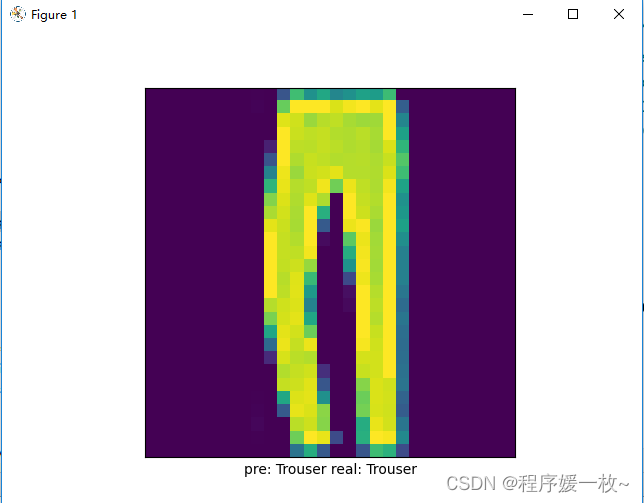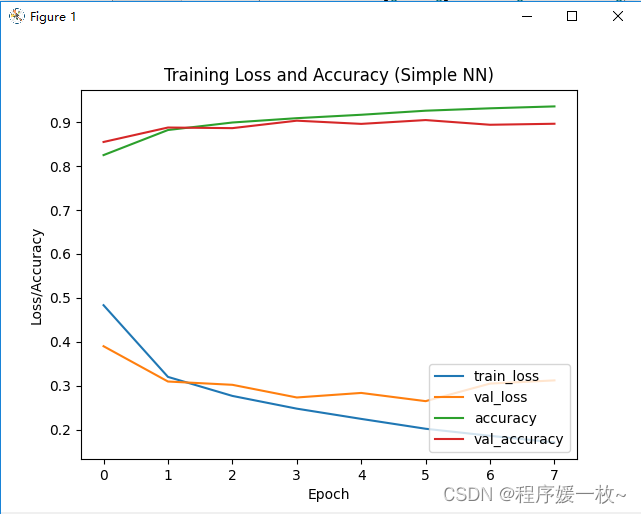记录|深度学习100例-卷积神经网络(CNN)服装图像分类 | 第3天
1. 服装图像分类效果图
原始训练图如下:

测试图:预测标签及实际标签如下:
可以看到正确预测

训练损失/准确度图:

2. 源码
# 深度学习100例-卷积神经网络(CNN)服装图像分类 | 第3天
# USAGE
# python img_fashion3.py
import matplotlib.pyplot as plt
import numpy as np
import tensorflow as tf
from tensorflow.keras import datasets, layers, models
gpus = tf.config.list_physical_devices("GPU")
if gpus:
gpu0 = gpus[0] # 如果有多个GPU,仅使用第0个GPU
tf.config.experimental.set_memory_growth(gpu0, True) # 设置GPU显存用量按需使用
tf.config.set_visible_devices([gpu0], "GPU")
# 导入数据
(train_images, train_labels), (test_images, test_labels) = datasets.fashion_mnist.load_data()
# 将像素的值标准化至0到1的区间内。
train_images, test_images = train_images / 255.0, test_images / 255.0
# 调整数据到我们需要的格式
train_images = train_images.reshape((60000, 28, 28, 1))
test_images = test_images.reshape((10000, 28, 28, 1))
print(train_images.shape, test_images.shape, train_labels.shape, test_labels.shape)
# class_names = ['T恤/上衣', '裤子', '套头衫', '连衣裙', '外套','凉鞋', '衬衫', '运动鞋', '包', '短靴']
class_names = ['T-shirt/top', 'Trouser', 'Pullover', 'Dress', 'Coat',
'Sandal', 'Shirt', 'Sneaker', 'Bag', 'Ankle boot']
# 可视化
plt.figure(figsize=(20, 10))
for i in range(20):
plt.subplot(5, 10, i + 1)
plt.xticks([])
plt.yticks([])
plt.grid(False)
plt.imshow(train_images[i], cmap=plt.cm.binary)
plt.xlabel(class_names[train_labels[i]])
plt.show()
# 构建网络
model = models.Sequential([
layers.Conv2D(32, (3, 3), activation='relu', input_shape=(28, 28, 1)), # 卷积层1,卷积核3*3
layers.MaxPooling2D((2, 2)), # 池化层1,2*2采样
layers.Conv2D(64, (3, 3), activation='relu'), # 卷积层2,卷积核3*3
layers.MaxPooling2D((2, 2)), # 池化层2,2*2采样
layers.Conv2D(64, (3, 3), activation='relu'), # 卷积层3,卷积核3*3
layers.Flatten(), # Flatten层,连接卷积层与全连接层
layers.Dense(64, activation='relu'), # 全连接层,特征进一步提取
layers.Dense(10) # 输出层,输出预期结果
])
model.summary() # 打印网络结构
# 编译模型
model.compile(optimizer='adam',
loss=tf.keras.losses.SparseCategoricalCrossentropy(from_logits=True),
metrics=['accuracy'])
# 训练模型
history = model.fit(train_images, train_labels, epochs=8,
validation_data=(test_images, test_labels))
pre = model.predict(test_images)
print('pre: ' + str(class_names[np.argmax(pre[2])]) + ' real: ' + str(class_names[test_labels[2]]))
plt.imshow(test_images[2])
plt.xticks([])
plt.yticks([])
plt.xlabel('pre: ' + class_names[np.argmax(pre[2])] + ' real: ' + str(class_names[test_labels[2]]))
plt.show()
plt.plot(history.history["loss"], label="train_loss")
plt.plot(history.history["val_loss"], label="val_loss")
plt.plot(history.history['accuracy'], label='accuracy')
plt.plot(history.history['val_accuracy'], label='val_accuracy')
plt.title("Training Loss and Accuracy (Simple NN)")
plt.xlabel('Epoch')
plt.ylabel('Loss/Accuracy')
# plt.ylim([0.5, 1])
plt.legend(loc='lower right')
plt.show()
test_loss, test_acc = model.evaluate(test_images, test_labels, verbose=2)
print(test_acc)




























 764
764











 被折叠的 条评论
为什么被折叠?
被折叠的 条评论
为什么被折叠?










